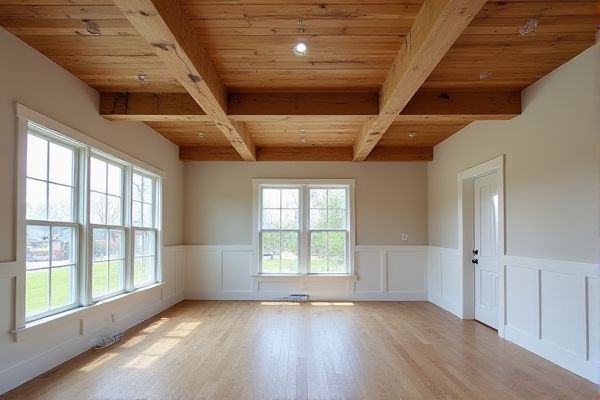
Exposed beam ceilings showcase the natural structure and warmth of wooden beams, adding rustic charm and architectural interest to Your space, while beadboard ceilings provide a more polished, textured look with narrow, vertical planks that enhance traditional or cottage-style decor. Discover which ceiling style best suits Your home's aesthetic and functionality by reading the rest of the article.
Table of Comparison
| Feature | Exposed Beam Ceiling | Beadboard Ceiling |
|---|---|---|
| Design Style | Rustic, industrial, or traditional charm with visible structural beams | Classic, cottage, or farmhouse look with narrow, grooved wooden panels |
| Material | Wood or metal beams, often structural | Wood or MDF beadboard panels |
| Installation | More complex; involves exposing or adding beams | Simpler; panel installation on flat ceilings |
| Cost | Higher due to materials and labor | More affordable, cost-effective option |
| Maintenance | May require periodic treatment for wood beams | Low maintenance; easy to clean or repaint |
| Ceiling Height Impact | Can make rooms feel taller and more spacious | May lower perceived ceiling height if added below existing ceiling |
| Insulation & Acoustics | Potentially less insulated; can amplify sound | Offers improved insulation and sound dampening |
| Best For | Homes seeking architectural interest and rustic appeal | Rooms needing a refined, textured ceiling finish |
Introduction to Ceiling Design Options
Exposed beam ceilings showcase structural beams as a key design feature, adding rustic charm and architectural interest to your space, while beadboard ceilings offer a classic, textured surface with narrow wooden planks that create a cozy, cottage-style ambiance. Both design options enhance interior aesthetics with distinct visual appeal and can influence the room's perceived height and lighting. Choosing between exposed beam and beadboard ceilings depends on your desired style, maintenance preferences, and the existing architectural elements in your home.
What Is an Exposed Beam Ceiling?
An exposed beam ceiling features visible structural beams, typically made of wood or metal, that add architectural interest and a rustic or industrial aesthetic to interiors. This ceiling style highlights the craftsmanship of the building, providing depth and texture while often enhancing natural light distribution. Exposed beams are commonly found in homes with vaulted ceilings or loft-style designs, contrasting with the uniform surface of beadboard ceilings.
What Is a Beadboard Ceiling?
A beadboard ceiling features narrow, vertical planks with distinctive grooves known as "beads," creating a textured, classic look. Unlike exposed beam ceilings that highlight structural wooden beams, beadboard ceilings offer a smooth, uniform surface that enhances cottage or farmhouse-style interiors. Your choice depends on whether you prefer the rustic charm of visible beams or the subtle elegance of beadboard paneling.
Aesthetic Appeal: Beams vs Beadboard
Exposed beam ceilings showcase rustic charm and architectural depth with their bold, structural elements, creating a warm, inviting atmosphere. Beadboard ceilings offer a more refined, classic look with narrow, vertical planks that add texture and subtle sophistication to your space. Your choice between beams and beadboard depends on whether you prefer a dramatic, rugged aesthetic or a clean, traditional finish.
Architectural Styles and Compatibility
Exposed beam ceilings complement rustic, industrial, and farmhouse architectural styles by showcasing raw wood textures and structural elements that add visual interest and warmth. Beadboard ceilings suit traditional, cottage, and coastal designs with their fine grooves and painted finish offering a clean, classic, and textured appearance. Both ceiling types enhance character and architectural authenticity but cater to different aesthetic preferences and interior themes.
Installation Process and Complexity
Exposed beam ceilings require precise structural integration and reinforcement, often involving skilled carpentry and potentially longer installation times due to the need for accurate alignment and secure fastening. Conversely, beadboard ceilings feature tongue-and-groove panels that interlock, allowing for a more straightforward and quicker installation process suitable for DIY projects. The complexity of installing exposed beams typically demands experienced professionals, whereas beadboard ceilings can be installed with basic carpentry tools and moderate skill.
Cost Comparison: Exposed Beams vs Beadboard
Exposed beam ceilings typically cost more due to the need for quality timber and intricate installation, often ranging from $15 to $30 per square foot depending on wood type and finish. Beadboard ceilings offer a more budget-friendly alternative, averaging $5 to $10 per square foot with easier installation and materials such as MDF, pine, or vinyl. Homeowners balancing aesthetics and budget often find beadboard ceilings more cost-effective, while exposed beams add distinctive architectural value but at a higher price point.
Maintenance and Durability
Exposed beam ceilings offer robust durability, with solid wood beams that resist wear and can last for decades when properly sealed and maintained, requiring occasional dusting and resealing to prevent moisture damage. Beadboard ceilings, made from tongue-and-groove panels, demand more frequent upkeep to avoid peeling paint and water stains, especially in humid environments, but their lightweight nature makes repairs easier and less expensive. Your choice between these ceilings should consider the trade-off between the long-term sturdiness of exposed beams and the simpler, though more frequent, maintenance needs of beadboard.
Insulation and Energy Efficiency
Exposed beam ceilings typically have less insulation coverage due to open joist spaces, which can result in higher heat loss and reduced energy efficiency compared to beadboard ceilings. Beadboard ceilings allow for continuous, enclosed surfaces that better accommodate insulation materials, improving thermal performance and reducing energy costs. Choosing beadboard can enhance indoor temperature regulation and lower heating and cooling expenses in residential spaces.
Which Ceiling Style is Right for Your Space?
Exposed beam ceilings showcase natural wood elements, creating a rustic or industrial ambiance ideal for spacious rooms with high ceilings, while beadboard ceilings offer a classic, textured look suited for cozy, traditional spaces or areas needing subtle architectural detail. Consider the room's size, ceiling height, and overall design theme to determine which style enhances the space's character and functionality. Exposed beams add visual interest and structural charm, whereas beadboard panels provide versatility and ease of installation for various interior styles.
 homyna.com
homyna.com